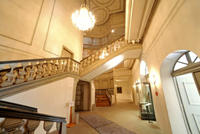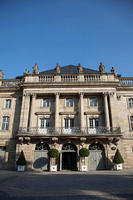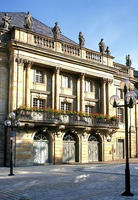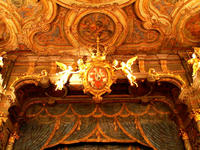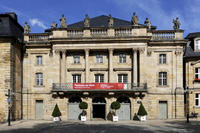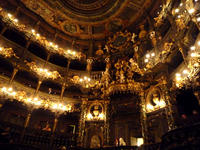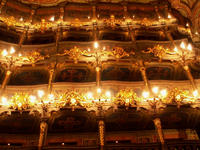You are in: Europe -> Germany -> Margravial Opera Hou... , and traditional search or Image Gallery will yield results of this site only
Margravial Opera House Bayreuth
| Site number: | 1379 |
|
| Type of site: | Cultural | |
| Date: | 1745 - | |
| Date of Inscription: | 2012 | |
| Location: | Europe, Germany, Bayreuth | |
Up to 75 images are shown here. Click on each for more details or on Image Gallery for more images.
| Description: | A masterpiece of Baroque theatre architecture, built between 1745 and 1750, the Opera House is the only entirely preserved example of its type where an audience of 500 can experience Baroque court opera culture and acoustics authentically, as its auditorium retains its original materials, i.e. wood and canvas. Commissioned by Margravine Wilhelmine, wife of Frederick, Margrave of Brandenburg–Beyreuth, it was designed by the renowned theatre architect Giuseppe Galli Bibiena. As a court opera house in a public space, it foreshadowed the large public theatres of the 19th century. The highly decorated theatre’s tiered loge structure of wood with illusionistic painted canvas represents the ephemeral ceremonial architectural tradition that was employed in pageants and celebrations for princely self-representation. --WHMNet's description is from WHC Site, where additional information is available. | |
| The Margravial Opera House (German: Markgräfliches Opernhaus) or Margrave's Opera House is a Baroque opera house in the town of Bayreuth, Germany, built between 1744 and 1748 by Joseph Saint-Pierre. It is one of Europe's few surviving theatres of the period and has been extensively restored. The interior was designed by Giuseppe Galli Bibiena and his son Carlo of Bologna in the late Baroque style. Princess Wilhelmine of Prussia, wife of the Frederick, Margrave of Brandenburg-Bayreuth, participated here as writer, player, composer, actor and director. Today she features in a sound-and-light presentation for tourists. The stage's great depth (27 metres) attracted Richard Wagner, who later had his Bayreuth Festspielhaus built north of the town. Each September from the year 2000 to 2009, the theatre hosted the Bayreuther Baroque festival, with performances of early operatic rarities. The 2009 festival included performances of Andrea Bernasconi's festa teatrale, L'Huomo, to a libretto by the Margravine Wilhelmine. On 30 June 2012 the opera house was inscribed in the UNESCO World Heritage List. The theatre will close in August of 2012 for extensive refurbishment and redevelopment, a process which is expected to take several years to complete. --Wikipedia. Text is available under the Creative Commons Attribution-ShareAlike License. | ||
| Source: | http://whc.unesco.org/en/list/1379 | |
| Reference: | 1. UNESCO World Heritage Center (http://whc.unesco.org/en/list/1379). 2. Wikipedia. | |


